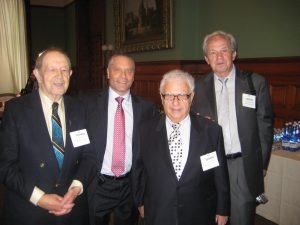How did a secular Jew, who didn’t even know he was Jewish until he was 11, become the world’s authority on Auschwitz?
Living in Holland with his family, the boy came home one day during the Six Day War and found his mother in tears. She feared that she was living the nightmare of World War II all over again, and confided in her son that they were Jewish. She had been hidden during the war and wanted to spare him her fate.
That boy, Robert Jan Van Pelt, grew up to become a historian at the University of Waterloo’s school of architecture. He became a renowned scholar on the architecture of Auschwitz and was called as a witness in the David Irving Holocaust denial trial in England. He prepared a documentary on Auschwitz for BBC News. His entire professional career has been devoted to expose the lie of Holocaust denial and to teach the truth of what happened
during the war years.
READ: BACKSTORY – JEWS HAVE FACED BDS MOVEMENT BEFORE
The life story of this journey toward Holocaust scholarship is remarkable. As a young boy, he was unable to attend high school due to grave illness and was home-schooled instead. But still he passed the university entrance exams and was admitted. He considers himself a kind of survivor to this day and identifies with his mother and all those who have overcome the most serious obstacles to testify to the value of life.
The real moment of epiphany, however, came during his PhD defence. His thesis was on the Cosmic Speculation of King Solomon’s Temple. One of the professors asked him if there is any building in our time that rivaled the Temple of Solomon in importance. Unprepared for the question and before really having a chance to think, he said, “Yes. Auschwitz.”
Thus a career was launched.
That career has led to a realization that both Rome and Jerusalem have shaped the history of Western civilization. Van Pelt’s research has attempted to find the balance, to retain the belief that we can enjoy the accomplishments of Western civilization and not lose the spiritual life offered by the Judeo-Christian faith
tradition.
As a historian of architecture, van Pelt feared that the architectural legacy had morphed from creations such as the Parthenon and the Pantheon into the concentration camps and the crematoria. What, indeed, had happened to what we consider “civilization” in order for such a transition to have taken place? Reflecting on the meaning and implication of the camps, forces consideration of what it means to be civilized. For that reason, van Pelt’s work is not morbid but rather a necessary corrective in the quest to understand what it is to be human.
What is unique and important about his research is the emphasis on physical evidence. Other scholars examine historical forces, events that occurred and effects on people and their lives, which are all valid approaches. Van Pelt’s rigorous and focused attention on the construction of the camps, and methods of mass murder, constitute irrefutable evidence of historical truth and a wakeup call to the conscience of humanity.
READ: BACKSTORY – THE ENIGMATIC FRANZ VON PAPEN AND THE CRYSTAL VASE
His current project is called The Evidence Room. It will be exhibited at the 2016 Architecture Biennale in Venice, attended by well over 200,000 visitors and attracting worldwide media attention. The project is an example of a new discipline: architectural forensics. The exhibit will consist of life-size casts of key pieces of evidence – for example, gas columns, blueprints, contractors’ bills – that demonstrate conclusively that the camp was purposely designed as a factory of death. After Venice, the exhibit will travel to a number of cities.
With each passing year, there are fewer and fewer Holocaust survivors to bear witness. They embody the memory of a tragedy so unspeakable that some would like to see it erased. Fortunately, there are scholars like Van Pelt who are dedicated to making that malignant objective virtually impossible.






